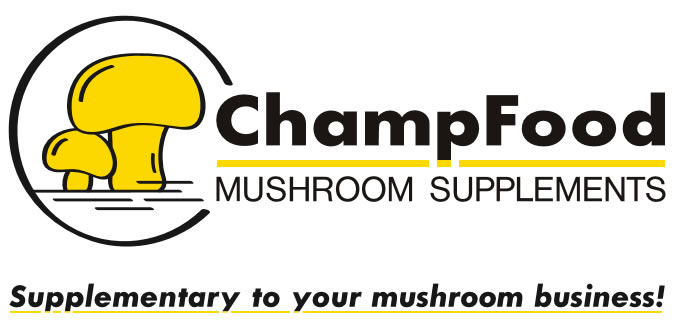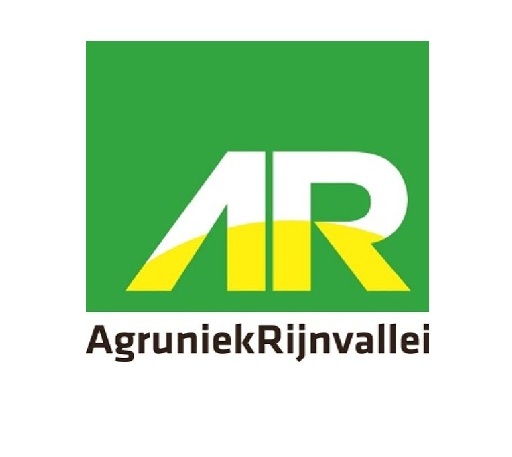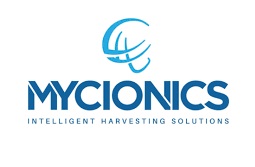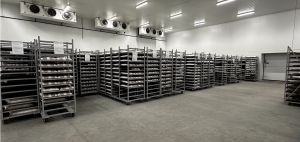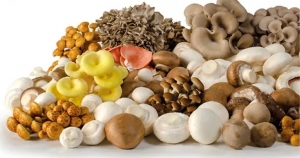A few years ago, we visited the spawn facility in Venlo - back then still operating under the name Lambert Spawn. Much has changed since. Time for a renewed introduction. We spoke with Ies Hooglugt, site manager of the Venlo location, about technology, collaboration and Ecovative’s ambitions.
The moment you walk into Ecovative’s production site in Venlo, it’s clear: serious work is being done here to produce top-quality spawn. Since the American company Ecovative took over around 2.5 years ago, a lot has changed and improved.
“We’ve truly matured as an organization,” says Ies Hooglugt. “The technology, the processes, and the people have all grown significantly.”
Spawn as core business
The Venlo factory is a well-known name in the spawn industry, formerly operating under the Lambert Spawn brand. Today, about 90% of production is focused on mushroom spawn and 10% on so-called “non-mushroom” applications, such as leather alternatives and mycelium-based packaging.
“That market is still in development. Promising, but young,” says Hooglugt. “Our core business remains the production of mushroom spawn.”
Within that 90%, the split is approximately 80% Agaricus and 20% exotics. “A valuable addition. We see great potential there, and the results are promising.”
From grain to custom solutions
One of Ecovative Venlo’s distinguishing features lies in the substrate used for growing spawn. While many suppliers use standard grain and straw, Venlo decided to look further.
“We used to work exclusively with millet, but that’s not suitable for every mushroom species,” explains Hooglugt. In collaboration with Belgian partner Mycelia - known for its extensive knowledge of exotics - new carriers were developed: Blend and Speed Spawn.
“We tailor the substrate to the mushroom, not the other way around. This results in faster and more efficient colonization of the substrate.”
Strategic partnership with Mycelia
The collaboration with Mycelia is strategic and goes far beyond just substrate or inoculum.
“For exotics, we work together at the highest level,” Hooglugt explains. “Mycelia brings decades of experience and deep knowledge of exotic species, and we contribute our production expertise. It’s a close collaboration - from strain selection to final spawn production.
For Agaricus, we now produce our own inoculum in-house, but for exotics we consciously build on Mycelia’s strength.”
According to Hooglugt, the triangle is solid: the American parent company provides scientific power, Mycelia brings practical expertise, and Venlo contributes production knowledge.
“All of these elements complement each other perfectly.”
Quality first
The acquisition by Ecovative has raised the bar. Internal processes have been tightened, and quality systems optimized.
“The advanced and unique system we use to make spawn is fairly complex. It requires well-trained people,” says Hooglugt. “Fortunately, we have a strong and stable team here, with hardly any turnover. That’s quite exceptional in this sector.”
He likes to compare it to Formula 1: “You can have the best car, but without a skilled driver, you won’t win the race. And vice versa. Here, everything lines up — people, technology and processes.”
Testing and research
Ecovative leaves nothing to chance, as shown by its close cooperation with research institutes. Spawn is tested at Inagro in Belgium, and the company works with Wageningen University & Research (WUR).
“WUR recently developed 16 sporeless oyster mushroom strains,” says Hooglugt. “These are freely available to the market, with the exception of the Purati, which is an exclusive release by Mycelia. And we’re producing the spawn.”
Growth ambitions
Although exports are going well, there’s still room to grow in the Dutch market.
“We’d like to expand domestically,” says Hooglugt. At the same time, he sees the market evolving. “There’s consolidation happening, growers are scaling up, and so are suppliers. That’s exactly why having alternatives is becoming more important.
We notice growers are making more conscious decisions.”
A great example is an Italian Pholiota grower who felt too dependent on his regular supplier.
“He actively sought a solid alternative, and we succeeded together,” Hooglugt shares. “We developed a new solution collaboratively. That’s what we stand for: flexibility, customisation and quality. It gives growers more control over their own process.”
After our visit to Venlo, one thing is clear. Ecovative stands strong, both literally and figuratively. The team knows what it stands for, operations are tightly managed, and the vision is clear. Most of all, the door is open for growers who want to move forward.
Team Mushroom Matter
The recent shortage of straw and hay in parts of North America and Europe has sparked a flurry of questions regarding what can be used as a substitute for compost ingredients. We thought a quick review of materials listed by Dr. Lee Schisler at the North America Mushroom Conference in the 80s and other materials that may be available around North America and elsewhere would be of some interest. There may be materials that we are not discussing that could be used as compost ingredients, but most likely in areas where better materials are not readily available.
Bulk Ingredients
Straw, whether it be straight wheat straw or bedded horse-manure straw, is the most common bulk ingredient used around the world. Other varieties like barley and rye can be used, although composting practices will need to be modified for these types of straw. The nitrogen, cellulose, hemicellulose, and lignin content of these straws may vary based on the variety, but differences are probably more related to where and how it is grown. Rice straw, although used in SE Asia, is generally not a desirable material as it is physically short, tough, and hard to break down. Oat straw is also a poor material; as it composts, it quickly becomes flat and soft, contributing to anaerobic conditions. Sorghum and sugar cane fodder can be used, but the stalks should be physically crushed before starting the composting process.
Corn fodder is starting to be used; our research has suggested 25% might be the most one could add to a straw-hay formula without negatively influencing yields. Its structure may also limit its use in systems that do not physically chop the fodder. In Pennsylvania and parts of Canada, mulch hay is a common bulk ingredient, timothy and orchard grasses being the most common varieties. Alfalfa can be used, but it is higher in N and physically can be more challenging to compost. Generally, in hay-based formulas, other bulk ingredients are used to provide additional carbohydrates to the formula. These bulk ingredients include corn cobs (ground or pelletized), cottonseed hulls (as is or pelletized). Less common are items such as hardwood bark or chips; deciduous leaves are used seasonally at one progressive farm, but the collection and storage of this material are challenging. Potato peel and slicer waste has been reported to be an option, but it is probably not commonly used because of problems associated with handling and storage of these high-moisture materials.
Other bulk ingredients that have been tried include peanut and rice hulls, but they are very high in lignin and hard to break down in the short composting times found at most commercial farms. Softwood barks have compounds (phenolic?) toxic to Phase 2 microbes and mushroom mycelium. Kenaf core, a by-product of the fiber collection process, and recycled paper wastes are possible ingredients, but at low amounts, say no more than 5-10% of the total volume. Additional research should be conducted, as paper waste is much different today than when this work was first reported in the 1970s. At this time, we consider spent mushroom compost as a filler material with no useable nutrients or used as an avenue to dispose of small quantities; however, research is being done to determine if larger quantities can be used as a bulk ingredient or as a supplement. Mushroom stumps are often disposed of in compost, but add little to the value of the compost.
Supplements
The “inorganic” sources of nitrogen, those with no carbohydrates, are historically used in synthetic formulas only and at no more than 25 lbs. per dry ton of other ingredients. The most common and only one still readily available is urea, often used with straight wheat straw formulas as a starter ingredient to “soften” the straw early in the pre-conditioning process. Calcium Cyanamid has been reported to be a substitute but must be pH adjusted and is not a commonly available ingredient, and hence not widely used. These inorganic supplements need to be added early in the composting process and are not readily available to the Phase II microbes.
More “organic” supplements, ones with carbohydrates readily available, are valuable but more expensive and therefore generally used later in the composting process to ensure there is a balanced formula. These ingredients include more common materials such as brewer’s and or distiller’s grain, cocoa bean hulls (contain an oil that microbes like), cottonseed meal, bedded poultry manure, ground soybean, rapeseed screenings, and sugar cane bagasse. Poultry manure for broilers is most common, but layer poultry manure, dried and processed, may also be used. The nitrogen content of poultry manure may vary depending on the source, number of flocks bedded on it, and other factors, so it is suggested to analyze the N content on a regular basis. Liquid poultry manure is used in some tunnel facilities that are designed to handle it. Rapeseed oil meal (expeller or solvent) or screenings are more likely to be available in the northern states and in Canada.
Other not so common supplements would be brewers dried yeast, buckwheat millings, castor bean meal, corn gluten feed (include bran), corn gluten meal, feather meal, fish solubles, linseed oil meal (Flax seed), malt sprouts, peanut oil meal, safflower oil meal (expeller or solvent), sesame oil meal (expeller or solvent), single cell protein, soybean screenings, soybean oil meal (expeller or solvent), cocoa hulls, sugar beet pulp (source of carbon), sunflower oil meal (expeller or solvent), wheat bran, wheat germ meal, and wheat mill run. Feather meal is high in N, so it is important to have a good distribution in the mixing. Fish solubles are high in moisture and difficult to handle.
Other feedlot manures can be used if generously bedded on straw with an effective pre-conditioning period, although I know of a small hobbyist grower who was composting straight cow manure (no straw) and successfully growing mushrooms. Blood meal has nitrogen, but in a form that has very little available to the microbes in Phase II. Apple pumice and paunch are too acidic and easily go anaerobic; therefore, they would not be adding desirable characteristics to the formula.
As you can see, there is a wide variety of raw materials available, and it is up to each of you to decide what works. What works in one part of the world, or at one farm, might not necessarily work in a different system. Material availability and economics will also play an important role in deciding what raw materials work for you.
The influence of straw on your composting process
Straw, horse manure and hay are the raw materials that have the most influence on the mushroom production process. Its structure affects the composting process. Its fibers (i.e. celluloses, hemicelluloses and lignin) are important carbon sources. The mycelium needs hemicelluloses and lignin for growth during the spawn run and case run phases (vegetative phase). In the so-called generative phase, from pin outgrow to mature mushrooms, celluloses and hemicelluloses are needed. Mushroom substrate has to undergo certain process steps. For the phase I composting process these are the so-called biological and chemical steps. During the phase II process the conversion of ammonia and the creation of selectivity make up the next step. During the phase III composting process the final step is mycelium development. Straw (or horse manure, hay) has a big impact on all these process steps.
Please read the full article on the website of ChampFood here
Article: by Geert Lemmers Composting Consultancy B.V.
Source: ChampFood


